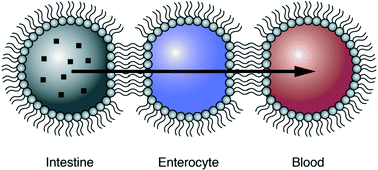A bespoke microfluidic pharmacokinetic compartment model for drug absorption using artificial cell membranes†
Abstract
Early prediction of the rate and extent of intestinal absorption is vital for the efficient development of orally administered drugs. Here we show a new type of pharmacokinetic compartment model that shows a threefold improvement in the prediction of molecular absorption in the jejunum than the current state-of-the-art in vitro technique, parallel artificial membrane permeability assays (PAMPA). Our three-stage pharmacokinetic compartment model uses microfluidic droplets and bespoke, biomimetic artificial cells to model the path of a drug proxy from the intestinal space into the blood via an enterocyte. Each droplet models the buffer and salt composition of each pharmacokinetic compartment. The artificial cell membranes are made from the major components of human intestinal cell membranes (L-α-phosphatidylcholine, PC and L-α-phosphatidylethanolamine, PE) and sizes are comparable to human cells (∼0.5 nL). We demonstrate the use of the microfluidic platform to quantify common pharmacokinetic parameters such as half-life, flux and the apparent permeability coefficient (Papp). Our determined Papp more closely resembles that of actual intestinal tissue than PAMPA, which overestimates it by a factor of 20.

- This article is part of the themed collection: Lab on a Chip Emerging Investigators


 Please wait while we load your content...
Please wait while we load your content...